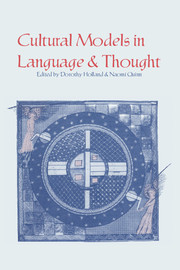Book contents
- Frontmatter
- Contents
- Preface
- List of Contributors
- Introduction
- Part I Presupposed worlds, language, and discourse
- 2 The definition of lie
- 3 Linguistic competence and folk theories of language
- 4 Prestige and intimacy
- 5 A folk model of the mind
- Part II Reasoning and problem solving from presupposed worlds
- Part III The role of metaphor and analogy in representing knowledge of presupposed worlds
- Part IV Negotiating social and psychological realities
- Part V An appraisal
- Index
4 - Prestige and intimacy
The cultural models behind Americans' talk about gender types
Published online by Cambridge University Press: 05 June 2012
- Frontmatter
- Contents
- Preface
- List of Contributors
- Introduction
- Part I Presupposed worlds, language, and discourse
- 2 The definition of lie
- 3 Linguistic competence and folk theories of language
- 4 Prestige and intimacy
- 5 A folk model of the mind
- Part II Reasoning and problem solving from presupposed worlds
- Part III The role of metaphor and analogy in representing knowledge of presupposed worlds
- Part IV Negotiating social and psychological realities
- Part V An appraisal
- Index
Summary
“ … I can't believe we're talking about this!”
Margaret, an informant in a study of college-age women, said this in the midst of a “talking diary” interview. Earlier, the interviewer had limited herself to questions that a friend or new acquaintance might ask: What's been happening since I talked to you last? How are your classes going? Who is this Alice that you're talking about? When did you join volleyball club? Then, at a point in the interview, Margaret began to describe a skit about “jocks,” “frat guys,” “Susie Sororities,” and other campus types. For a time, Margaret answered the interviewer's questions about the different types and how they could be identified and then interrupted herself:
Margaret: … I can't believe we're talking about this!
Interviewer: Why?
Margaret: I don't know. You just don't sit around talking about it that much with anybody. It's just kind of there.
Interviewer: So it's not the sort of thing you'd sit around in your dorm room and talk about to your roommates?
Margaret: No, you allude to it more than anything else.
Interviewer: What do you mean, allude?
Margaret: You know, little things, like, “Oh, you're wearing your add-a-beads today.” Things like that.
Interviewer: And that's all you have to say?
Margaret: Yeah, it's understood.
As might be expected, our participant–observation and interview data from a group of college-age Americans shows such types to be a conventional way of talking about other people.
- Type
- Chapter
- Information
- Cultural Models in Language and Thought , pp. 78 - 111Publisher: Cambridge University PressPrint publication year: 1987
- 48
- Cited by



